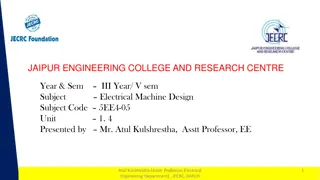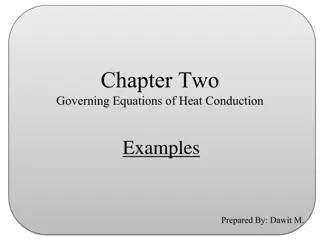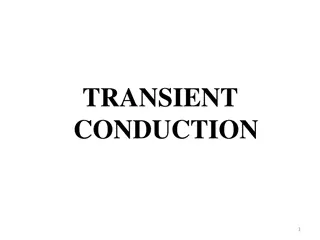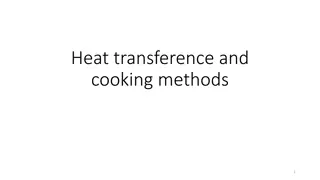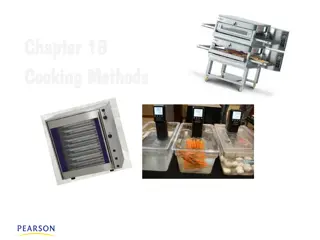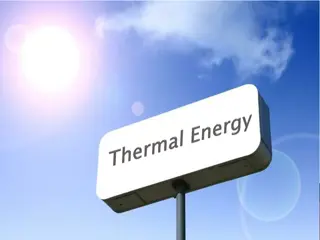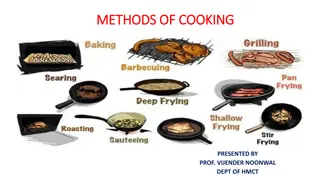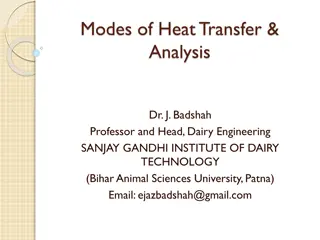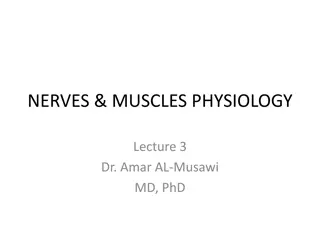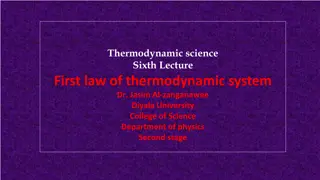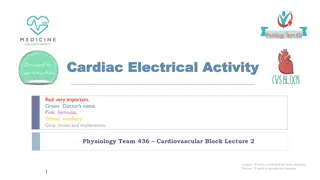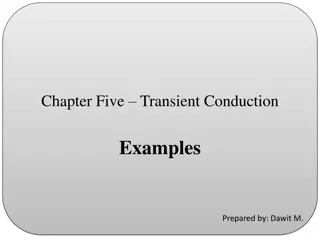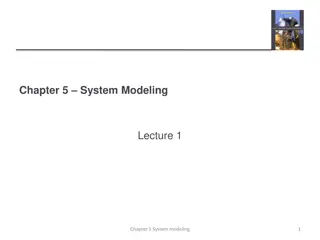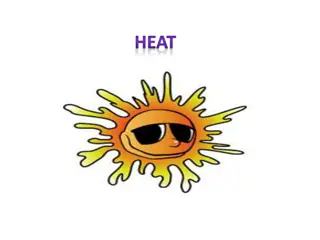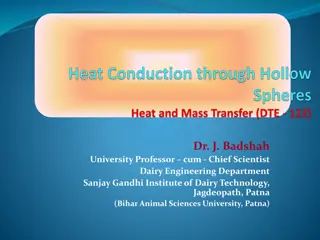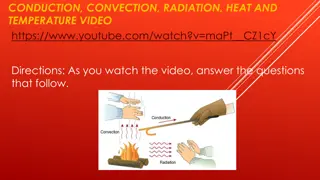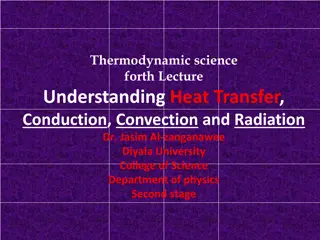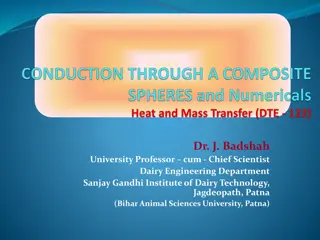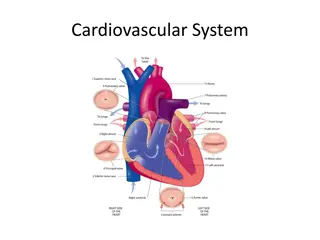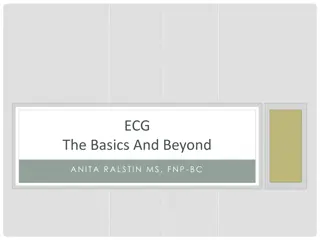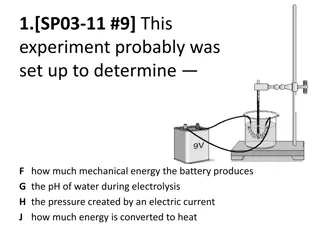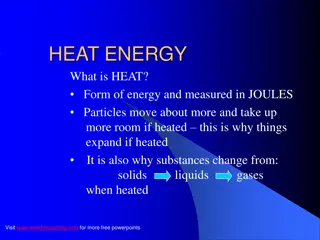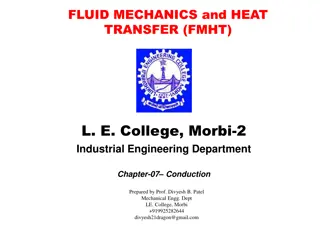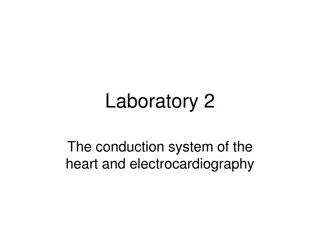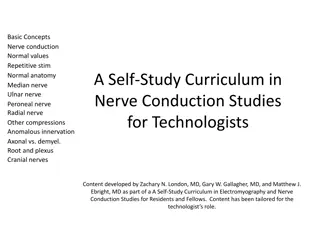SMALL FIBRE
Small fiber neuropathy involves thin and unmyelinated nerve fibers, leading to various sensory disturbances. The Erlanger and Gasser classification details the different types of nerve fibers involved. Symptoms include burning, tingling, and numbness, often presenting in a stocking-glove pattern. Di
4 views • 53 slides
System Models in Software Engineering: A Comprehensive Overview
System models play a crucial role in software engineering, aiding in understanding system functionality and communicating with customers. They include context models, behavioural models, data models, object models, and more, each offering unique perspectives on the system. Different types of system
3 views • 33 slides
Electrical Machine Design: Thermal Considerations and Heat Flow Analysis
This content provides insights into thermal considerations in electrical machine design, focusing on maximum operating temperatures, insulation factors, and heat flow mechanisms through convection, conduction, and radiation. It discusses the impact of temperature on insulation life and the methods o
1 views • 13 slides
ECE 305 Electromagnetic Theory
Explore the fundamental concepts of electric fields in material space, covering topics such as free space, conductors, insulators, semiconductors, current conduction, and charge density. Delve into the properties of materials, convection vs. conduction current, and the role of superconductors in ele
1 views • 25 slides
Understanding Hydrocollator Packs for Moist Heat Therapy
Hydrocollator packs are a form of superficial heat modality that utilize moist heat to transfer energy to the skin through conduction. These packs, filled with silica gel like bentonite, provide soothing heat for 30-40 minutes when heated in a hydrocollator unit. They come in various sizes and shape
8 views • 11 slides
Antiarrhythmics
Cardiac arrhythmias are a common cause of death in patients with heart conditions. These abnormalities in heart rhythm can be due to issues with impulse generation or conduction. Antiarrhythmic medications play a crucial role in managing these conditions by affecting the action potentials of cardiac
3 views • 14 slides
Chapter Two Governing Equations of Heat Conduction
This compilation covers examples and governing equations of heat conduction, including boundary conditions and scenarios involving one-dimensional conduction in various structures. It explores scenarios like steady-state conditions in a plane wall, heat conduction along a pipeline, and temperature d
0 views • 12 slides
Understanding Transient Conduction in Heat Transfer
Transient conduction in heat transfer occurs when boundary temperatures change, causing temperature variations within a system until a steady state is achieved. This phenomenon is commonly seen in processes like quenching hot metals. The Lumped Capacitance Method is used to analyze such scenarios, i
0 views • 55 slides
Understanding Heat Transfer and Cooking Methods
Explore the various methods of heat transfer and cooking techniques, including moist-heat and dry-heat methods. Learn about the objectives of heating foods, types of heat transfer such as conduction and convection, and how different methods affect the texture, flavor, and nutritional content of food
0 views • 21 slides
Understanding Cooking Methods: Heat Transfer and Dry-Heat Techniques
Learn about heat transfer methods such as conduction, convection, and radiation, along with dry-heat cooking techniques like sautéing, grilling, roasting, and more. Discover how heat energy is applied in various cooking processes to create delicious dishes.
0 views • 25 slides
Understanding Calcium Metabolism: A Comprehensive Overview
Calcium metabolism plays a critical role in various bodily functions like nerve conduction, coagulation, and bone mineralization. It involves processes such as calcium absorption, distribution, and homeostasis, regulated by hormones like PTH and calcitriol. The balance of calcium in the body is cruc
7 views • 50 slides
Finite Element Analysis of Heat Transfer Problems
Analogy between stress analysis and heat conduction analysis is discussed. Various thermal problems, including steady-state heat transfer and governing differential equations, are explored. Conservation of energy and boundary conditions are detailed for solving thermal analysis problems.
0 views • 35 slides
Understanding Thermal Energy: Transfer & Transformation
Explore thermal energy and its transfer mechanisms such as conduction, convection, and radiation. Learn how thermal energy moves between objects of different temperatures, and why heat is always transferred, not coldness. Enhance your knowledge on the fascinating world of thermal energy dynamics.
0 views • 14 slides
Understanding Local Anesthetics: Mechanism, Characteristics, and Pharmacokinetics
Local anesthetics (LAs) block nerve impulse conduction effectively for pain management without motor blockade. Their chemistry, including lipophilic groups and ionizable groups, contributes to their efficacy. LAs have rapid onset, long duration, reversibility, and minimal side effects. Pharmacokinet
0 views • 30 slides
Understanding Cooking Methods: Conduction and Convection Explained
Cooking methods like conduction and convection are fundamental in culinary arts. Conduction involves direct heat transfer through matter, while convection utilizes the movement of fluids for heat transfer. Gravity and buoyancy play crucial roles in natural convection processes, resulting in efficien
1 views • 45 slides
Understanding Heat Transfer: Conduction, Thermal Conductivity, and More
Explore the fundamentals of heat transfer through conduction and thermal conductivity as explained by Dr. J. Badshah. Learn about the modes of heat transfer, Fourier's law, thermal resistance, and the relationship between thermal and electrical conductivity. Discover the essential features of therma
1 views • 9 slides
Understanding Nerves and Muscles: Physiology Insights by Dr. Amar AL-Musawi MD, PhD
Explore the intricate world of nerve fiber morphology, myelination, and classification in this enlightening lecture by Dr. Amar AL-Musawi. Delve into the significance of myelination in enhancing nerve function and learn about factors affecting conduction velocity. Discover the role of glial cells in
0 views • 15 slides
Understanding the First Law of Thermodynamics in Science Lectures
Explore the concept of the First Law of Thermodynamics through a series of engaging science lectures by Dr. Jasim Al-zanganawee from Diyala University. Learn about energy transfer, conservation, internal energy of ideal gases, and how heat and work impact a system's total energy. Discover the relati
0 views • 15 slides
Understanding Cardiac Electrical Activity in Physiology Team's Cardiovascular Block Lecture
Dive into the intricate details of cardiac electrical activity in this lecture led by Physiology Team 436. Explore topics like the cardiac conductive system, action potentials, refractory periods, excitation-contraction coupling, and the effects of autonomic stimulation on heart electrophysiology. D
0 views • 29 slides
Transient Conduction in Thermal Energy Storage Units and Cylinders
Explore examples of transient conduction phenomena in thermal energy storage units, cylinders, and spheres. Learn how to calculate time durations, temperature changes, and energy removal rates during these heating and cooling processes. The examples cover scenarios involving aluminum slabs, oil bath
0 views • 10 slides
Understanding the Electrical Activities of the Heart - An Overview
The electrocardiogram (ECG) is a result of intricate physiological and technological processes involving transmembrane ionic currents, cardiac activation sequences, and electrode connections. The cardiac conduction system consists of various components like the sinoatrial node, atrioventricular node
0 views • 39 slides
Understanding System Modeling in Engineering
System modeling in engineering involves developing abstract models to represent a system from various perspectives using graphical notations like UML. These models aid in understanding system functionality, communicating with stakeholders, and documenting requirements for new systems. Existing and p
2 views • 53 slides
Understanding the Impact of Temperature on Fermi Level in Semiconductors
The Fermi level plays a crucial role in determining the behavior of electrons in semiconductors at different temperatures. As temperature increases, the Fermi level shifts, affecting the generation of free electrons and holes in the valence and conduction bands. In intrinsic semiconductors, electron
2 views • 53 slides
Understanding Heat Energy Transfer and Principles
Heat energy is the result of particle movement in solids, liquids, and gases. It can be transferred through conduction, convection, and radiation. Conduction occurs through direct contact, convection involves the movement of fluids, and radiation transfers heat through empty space. Understanding how
1 views • 14 slides
Understanding Heat Conduction Through Hollow Spheres in Dairy Engineering
Dr. J. Badshah, a University Professor cum Chief Scientist at Sanjay Gandhi Institute of Dairy Technology, explains the conduction through hollow spheres with varying thermal conductivity. The concept of logarithmic mean area for hollow spheres and solving numericals related to conduction through a
1 views • 6 slides
Understanding Heat Transfer: Conduction, Convection, Radiation
Explore the concepts of conduction, convection, and radiation in heat transfer through an engaging video. Learn how thermal energy is transferred through solids, liquids, and gases, and understand the role of insulation in preventing heat transfer. Discover why hot water rises and cold water sinks,
0 views • 5 slides
Understanding Heat Transfer in Thermodynamics Lecture
This thermodynamics lecture covers essential topics such as heat transfer, conduction, convection, and radiation. Dr. Jasim Al-zanganawee from Diyala University explains Thermodynamic Processes, Internal Energy, Properties of a System, and Thermodynamic Cycles. Students will learn about extensive an
0 views • 11 slides
Thermal Conduction Analysis in Composite Sphere and Cylinder
Dr. J. Badshah, a distinguished university professor and chief scientist, discusses thermal conduction through cylindrical walls and composite structures like spheres and cylinders. The analysis includes equations for heat transfer rates, numerical examples, and insights into critical insulation thi
0 views • 10 slides
Understanding the Cardiovascular System: An Overview
The cardiovascular system, comprising the heart and blood vessels, plays a vital role in delivering oxygen and nutrients to body tissues. Arteries carry oxygenated blood away from the heart, veins transport deoxygenated blood back to the heart, and capillaries facilitate nutrient exchange. Learn abo
0 views • 21 slides
Understanding Heat Transfer in Science
Investigate and understand the movement of heat between objects through conduction, convection, and radiation. Learn to compare materials that conduct heat with insulating materials, describe heat transfer processes, and design experiments to study heat energy movement. Explore the use of ratio reas
0 views • 31 slides
Understanding ECG: Basics and Beyond
Explore the fundamentals of ECG interpretation, including cardiac conduction system, heart rate calculation methods, and characteristics of normal sinus rhythm. Gain insights on treating the patient based on ECG findings and understanding the correlation between electrical and mechanical activity in
0 views • 28 slides
Understanding Local Anesthesia and Nerve Conduction Blockade
Local Anesthetics (LAs) are drugs that abolish sensations like pain in specific body areas by blocking nerve conduction of sensory impulses. This process involves reducing the influx of sodium ions, preventing membrane depolarization, and inhibiting action potential conduction. LAs are weak bases wi
0 views • 22 slides
Understanding Extrinsic Semiconductors: Fermi Level and Doping Effects
Extrinsic semiconductors play a crucial role in modern electronics by allowing controlled addition of impurities to tailor conductivity. The Fermi level in extrinsic semiconductors shifts based on the number of electrons and holes in the conduction and valence bands, influencing conductivity. Doping
0 views • 14 slides
Understanding Heat Transfer in Scientific Experiments
Explore various scientific experiments related to heat transfer, including determining energy produced by batteries, heat convection in gases and liquids, detecting warmth through a door, energy transformations in the Earth system, and optimizing solar heaters. Learn about conduction, convection, ra
0 views • 16 slides
Understanding Heat Energy Transfer and Conduction in Materials
Heat energy is a form of energy measured in joules that causes particles to move faster, expand, and change states. Learn about the difference between heat and temperature, heating and cooling processes, and the methods of energy transfer such as conduction. Discover how materials conduct heat diffe
0 views • 18 slides
Understanding Heat Transfer: Conduction, Convection, and Radiation
Heat transfer is a fundamental process that occurs through conduction, convection, and radiation. Conduction involves the transfer of heat between particles through direct contact, while convection moves heat within fluids and gases through currents. Radiation is heat transfer through electromagneti
0 views • 13 slides
Understanding the Conduction System of the Heart and Electrocardiography
This laboratory focuses on the conduction system of the heart and electrocardiography, covering topics such as the anatomy of the internal conduction pathway, normal electrocardiogram interpretation, and the role of autorhythmic cells and pacemakers. The content also includes information on electrod
0 views • 16 slides
Understanding Electrical Concepts in Nerve Conduction Studies
Exploring the fundamental electrical properties in nerve conduction studies, including charge, voltage, current, and impedance. Learn about normal values, anatomy, and anomalies in nerve function. This self-study curriculum is designed for technologists interested in electromyography and nerve condu
0 views • 73 slides
Understanding Heat Conduction and Transfer in Thermal Systems
Explore the fundamental concepts of heat conduction and transfer, including Fourier's law, steady-state conduction, thermal resistance, multi-layered systems, cylindrical objects, and overall heat transfer coefficients. Discover how to analyze boundary conditions, calculate critical insulation thick
0 views • 20 slides
Understanding Heat Transfer: A Comprehensive Overview
Heat transfer is a fundamental concept in physics, where energy moves from hot to cold objects through conduction, radiation, and convection. Heat is not a substance but a form of energy that speeds up molecules. Conduction transfers heat between substances in direct contact, while convection involv
0 views • 13 slides


